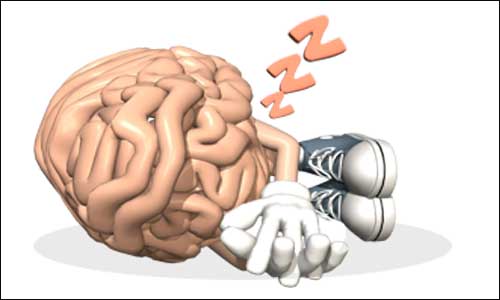
sing designer genes, researchers at UB and Harvard were able to ‘turn on’ specific neurons in the brainstem that result in deep sleep. Image: Dreamstime
Neuroscientists at University of Buffalo have identified a sleep-promoting circuit inside the brainstem or the primitive part of the brain, whose activity appears to be both necessary and sufficient to produce deep sleep. This is only the second ‘sleep node’ in the mammalian brain that was identified to serve this function. To demonstrate the sleep node’s function, the researchers used molecular tools that activate neurons in this region of the brain and found the test animals quickly fell into deep sleep. Thus, the research highlights an alternate and novel therapy for treating sleep disorders like insomnia without using sedatives.
Where the Zzz comes from
The brain stem is the posterior area of the brain that attaches to the spinal cord. Here information is sent back and forth between the cerebrum or cerebellum and the body. It’s also called the primitive part of the brain because it was the first brain structure to evolve, and is responsible for our basic vital functions like breathing, blood pressure, heart rate and body temperature.
“The close association of a sleep center with other regions that are critical for life highlights the evolutionary importance of sleep in the brain,” says Caroline E. Bass, assistant professor of Pharmacology and Toxicology in the UB School of Medicine and Biomedical Sciences and a co-author on the paper.
The team found that nearly half of the brain’s sleep-promoting activity originates from the parafacial zone (PZ) in the brainstem. It is here that they identified a key type of neuron that produces a neurotransmitter called gamma-aminobutyric acid (GABA), which effectively puts your into a deep sleep state. To test their findings, the researchers introduced a ‘designer’ virus into the PZ that expressed a receptor on GABA neurons only, without altering other brain functions. When the scientists turned on the GABA neurons in the PZ, the animals quickly fell into a deep sleep without the use of sedatives or sleep aids.
“These new molecular approaches allow unprecedented control over brain function at the cellular level,” says Christelle Ancelet, postdoctoral fellow at Harvard School of Medicine. “Before these tools were developed, we often used ‘electrical stimulation’ to activate a region, but the problem is that doing so stimulates everything the electrode touches and even surrounding areas it didn’t. It was a sledgehammer approach, when what we needed was a scalpel.”
It’s yet unclear how these newly identified neurons in the PZ region interact with other well known sleep and wake-promoting brain regions. The UB researchers plan on extensively studing this relationship and hope that their work might eventually render a novel type of medication for treating sleep disorders, as well as better and safer anesthetics.
“We are at a truly transformative point in neuroscience,” says Bass, “where the use of designer genes gives us unprecedented ability to control the brain. We can now answer fundamental questions of brain function, which have traditionally been beyond our reach, including the ‘why’ of sleep, one of the more enduring mysteries in the neurosciences.”
Findings were reported in the journal Nature Neuroscience.









